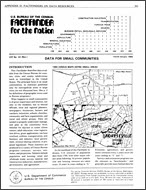Factfinder for the Nation: Data for Small Communities
Factfinder for the Nation: Data for Small Communities
Introduction
This Factfinder describes data available from the Census Bureau for counties, cities, and county subdivisions (such as townships) in the United States. The principal focus is on small communities, so statistics published only for metropolitan areas or large cities are not discussed here. (See p. 2 for definitions of geographic terms used in Bureau programs.)
What happens in small communities is of great importance and interest, not only to the residents, but to elected officials, local and regional planners, newspapers, businesses, farmers and ranchers, industries, schools, churches, community and farm organizations, and racial and ethnic groups. Data are needed to properly understand, manage, and plan at the community level, whether for daycare or senior citizen centers, adult education, voter registration drives, grant applications, tax-base overhaul, utilities, transportation, new business and industry, local government, revenue-sharing concerns, or proposed legislation. These statistics are produced in a variety of Census Bureau programs—censuses, surveys, estimates, and projections. Subjects include population and housing; retail and wholesale trade; service, mineral, and construction industries; manufactures; governments; and agriculture.
As the masthead of this Factfinder indicates, U.S. censuses of population date from 1790, with other major subject areas following. At present, population and housing censuses are taken every 10 years in years ending in "0." Economic, agriculture, and governments censuses every 5 years cover the years ending in “2" and "7."
Surveys and estimation programs use the censuses as “benchmarks, " and generally provide more limited data for the years between censuses. Special censuses of population are occasionally conducted under contract with local communities in years between the major decennial censuses.
Taken under the provisions of Title 13, United States Code, all of the Bureau's censuses and most of its surveys are mandatory. Except for statistics on governments, which are a matter of public record, and on foreign trade, all data collected by the Bureau are confidential by law, with serious penalties for disclosure.1 To avoid identification of data for any individual, household, or firm, all published tabulations—whether in printed or computerized form—are screened and, if necessary, the item in question is either suppressed or combined with similar data at a higher level of geography.
The following sections briefly describe the Census Bureau data relevant to small communities. Only the latest final reports (a few of which carry comparative data for earlier periods) are considered. Figure 2 on pages 6 and 7 shows the various types of data published and the media in which they are available. Maps are discussed on page 8.
__________
1 Population census records in the custody of the National Archives are opened to the public after 72 years. Meanwhile. the Census Bureau releases transcripts of individual records only to the named persons, their authorized representatives, or heirs (on proof of death).
Information about individual property values and sales prices, collected in the census of governments, is subject to the confidentiality provisions of Tit1e 13.
Others in Series
Publication
Publication
Publication




